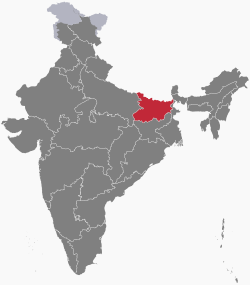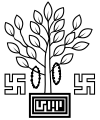Bihar
|
Bihar बिहार |
||
|---|---|---|
| State | ||

80-foot Gautam Buddha, Bodh Gaya, Bihar
|
||
|
||
 Location of Bihar in India |
||
| Coordinates (Patna): 25°22′N 85°08′E / 25.37°N 85.13°ECoordinates: 25°22′N 85°08′E / 25.37°N 85.13°E | ||
| Country |
|
|
| Statehood | 26 January 1950 | |
| Capital | Patna | |
| Largest city | Patna | |
| Districts | 38 | |
| Government | ||
| • Governor | Ram Nath Kovind | |
| • Chief Minister | Nitish Kumar | |
| • Legislature |
Bicameral Legislative Council 75 Legislative Assembly 243 |
|
| • Parliamentary constituency | 40 | |
| • High Court | Patna High Court | |
| Area | ||
| • Total | 94,163 km2 (36,357 sq mi) | |
| Area rank | 13th | |
| Population (2011) | ||
| • Total | 103,804,637 | |
| • Rank | 3rd | |
| • Density | 1,102/km2 (2,850/sq mi) | |
| Demonym(s) | Bihari | |
| Time zone | IST (UTC+05:30) | |
| UN/LOCODE | INBR | |
| ISO 3166 code | IN-BR | |
| Vehicle registration | BR | |
| HDI |
|
|
| HDI rank | 16th (2010) | |
| Literacy | 63.8% (total) 73.5% (male) 53.3% (female) |
|
| Official language | Hindi | |
| Additional official language | Urdu | |
| Website | gov |
|
| Symbols of Bihar | ||
| Animal | Ox(बैल) | |
| Bird | Sparrow(गौरैया) | |
| Flower | Marigold(गेंदा) | |
| Tree | Peepal(पीपल) | |
| Climate | |
|---|---|
| Classification | ETh |
| Avg. temperature | 27 °C (81 °F) |
| • Summer | 34 °C (93 °F) |
| • Winter | 10 °C (50 °F) |
| Precipitation | 1,200 mm (47 in) |
| Population growth | |||
|---|---|---|---|
| Census | Pop. | %± | |
| 1951 | 29,085,000 |
—
|
|
| 1961 | 34,841,000 | 19.8% | |
| 1971 | 42,126,000 | 20.9% | |
| 1981 | 52,303,000 | 24.2% | |
| 1991 | 64,531,000 | 23.4% | |
| 2001 | 82,999,000 | 28.6% | |
| 2011 | 104,099,452 | 25.4% | |
| Source:Census of India | |||
Bihar (/bᵻˈhɑːr/; Hindustani pronunciation: [bɪˈɦaːr]) is a state in the eastern part of India. It is the 13th-largest state of India, with an area of 94,163 km2 (36,357 sq mi). The third-largest state of India by population, it is contiguous with Uttar Pradesh to its west, Nepal to the north, the northern part of West Bengal to the east, with Jharkhand to the south. The Bihar plain is split by the river Ganges which flows from west to east.
On November 15, 2000, southern Bihar was ceded to form the new state of Jharkhand. Only 11.3% of the population of Bihar lives in urban areas, which is lowest in India after Himachal Pradesh. Additionally, almost 58% of Biharis are below the age of 25, giving Bihar the highest proportion of young people of any Indian state. The official languages of the state are Hindi and Urdu. Other languages commonly used within the state include Bhojpuri, Maithili, Magahi, Bajjika, and Angika (Maithili is the only one of these to be officially accepted by the government).
In ancient and classical India, Bihar was considered a centre of power, learning, and culture. From Magadha arose India's first empire, the Maurya empire, as well as one of the world's most widely adhered-to religions, Buddhism. Magadha empires, notably under the Maurya and Gupta dynasties, unified large parts of South Asia under a central rule.
...
Wikipedia

